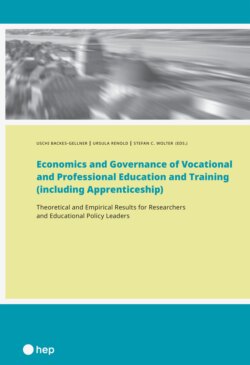Читать книгу Economics and Governance of Vocational and Professional Education and Training (including Apprenticeship) (E-Book) - Uschi Backes-Gellner - Страница 14
На сайте Литреса книга снята с продажи.
Narrow versus Broad Skills Set
ОглавлениеList questioned the distinction between productive and unproductive employment, which is central to the Smith model (Winch, 1998). List stressed the importance of social responsibility for the community and the importance of negotiation processes at the national level and calls for good education for all. List’s economic concept is deeply rooted in his moral and religious motivation for action. Such attitudes are a prerequisite for working diligently, cooperating with others, and striving for continuous improvement.
Institutions like trade and craft guilds, and the apprenticeships associated with them, embody the skills on which production rests; they also provide the possibility for the nurturing and development of skills across generations, so that some skills may take generations to build up through refinement within a stable institutional base. Finally, the ‘porous’ (not solely economic) nature of such institutions provides the religious, social and moral motivation to maintain skill and to build on it (Winch, 1998, p. 370).
Hence, Smith’s division of labor concept leads to a division of education that is not the case in the Listian approach.
Transferring this consideration to the present time, the following examples illustrate how the basic foundations of these concepts are visible in today’s educational concepts. One might think, for example, of sales talks with young adults employed by a retailer in the USA or Switzerland. While the formers are rather narrowly trained for simple sales activities (Lerman, 2012), Swiss young people complete a three-year training program in retail and acquire multiskilled competence sets that can be performed in all companies in that industry sector due to the federal recognized diploma. The following contemporary examples illustrate such differences.
On the US apprenticeship website, a “registered apprenticeship cook & services”[5] offer from McDonalds in Prospect, KY, is advertised as follows:
We’re looking for big smiles, great attitudes, hard workers and team players to join our McDonald’s Crew! As a McDonald’s Crew Member, you’re responsible for: Greeting customers with a smile and providing hospitality. Taking accurate food orders. Preparing McDonald’s food. Meeting sales and speed targets during your shift. Keeping the restaurant clean and safe. Abiding by all Samax personnel and food safety policies. We offer flexible scheduling, on-the-job training, free food and uniforms, and so much more. Come join us for a job that is both challenging and fun! Crew members are entry-level positions and require no formal training prior to employment. $8.25–$11.00 per hour (Program type: NFE 1).
McDonalds in Zurich—a subsidiary of the same multinational company—offers a dual VET program called system gastronomy specialist. This is a three-year program that is guided through a national framework curriculum for all learning locations and leads to a federally recognized VET diploma from the respected Ministry of Education. The qualification profile relevant for this occupation in any company, be it McDonalds or a local Swiss restaurant, was elaborated by the respective national professional association together with educational institutions and can be summarized as follows:
System catering experts at the EFZ level are capable of recording, organizing, and evaluating system catering processes holistically. They live the philosophy of their business and are characterized by a pronounced guest orientation and a flair for sales. They are aware of the importance, the characteristics, the quality and sustainability requirements of food applications. They procure them according to specifications, store them in a variety-specific and quality-conscious manner, and prepare them professionally for preparation. They are aware that costs are incurred in a company and during their work. They know these costs, make simple calculations, and use the appropriate tools. They are aware of the effects of their work on people and society. They behave in accordance with the standards of professional ethics and thus help to ensure that their work is sustainable for society. They are aware that operational procedures and processes only function if employees organize their work in a way that is appropriate for the company. They organize their own work rationally in accordance with general and operational requirements and in accordance with deadlines. In their work, they implement the regulations and standards of occupational safety, health protection, sustainability, environmental protection, and hygiene in a dutiful manner. They communicate in the “English language” in a manner appropriate to the situation and the addressees (pp. 2–3[6]) (Program type: FE 4).
It is obvious that education activities are very different in the USA and Switzerland. While young people completing such a nationally regulated VET program in system gastronomy at McDonald Switzerland can easily work for another company in the same sector, this is unlikely to be the case in the USA because there is no mandatory national, cross-company curriculum as a basis for training or education (see Lerman, 2010). The striking differences in this example also have to do with the length of the training. While in Switzerland, there is a three-year in-company training program combined with education in Vocational Schools according to a well-defined curriculum, the on-the-job training in the USA is not specified externally. Experience shows that such training usually lasts a few days to a few weeks. It is not so much a question of training the entire industry with highly qualified specialists but rather of a labor-market integration program with a short-term perspective that resembles the Adam Smith division of labor approach (Ryan, 2000).
